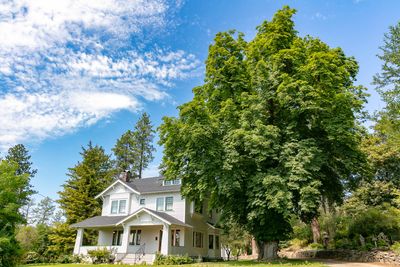
Built in 1910, the Keller House is a spacious, modified bungalow-style house and an excellent example of the English Craftsman movement and well maintained in that style. The Keller House was one of the first homes in Colville to have electricity.
The Youngs and Kellers were the only people who lived in the house before it became city property.
In 1975, the City of Colville agreed to have the Stevens County Historical Society manage the property and buildings it had received a decade earlier as a gift from the Louis Keller. The terms of Louis Keller’s gift required the house and grounds be a park and museum. Citizens of Colville wanted to save the first Colville schoolhouse. Before Keller’s death, he allowed these citizens to move the log schoolhouse building onto the property.
The Historical Society had some artifacts in a small building on Wynne Street near 1st Avenue and needed a larger facility. Using Bessie McDowell’s financial gift, the Society added a modest, concrete block museum structure.
Although the building was small, it was sufficient in 1975 to house the artifacts it had. The Society placed some of its artifacts in the Keller House. For the first twenty or so years, the Keller House had caretakers living in it. This arrangement worked out well, as the caretakers paid for lights and heat and let people come through their residence in exchange for living in the house.
At about the same time, in the early 1990s, the Historical Society received a sizable financial gift and a gift of furniture and household goods originally in the Keller House. With this donation, the Society extended the museum, including an upstairs caretaker’s apartment and storage area.
The Keller Heritage Center includes the Graves Mountain Lookout Tower, a mining exhibit including a miner’s cabin, a fur trapper’s cabin, a blacksmith display, a sawmill display, a machinery display building, a homestead log cabin, and the original Colville Schoolhouse.